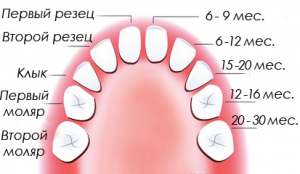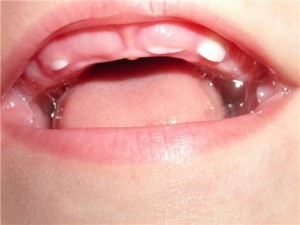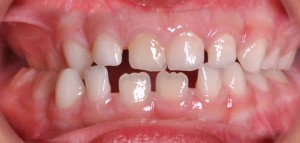Milk bite

Dentists distinguish three stages in the development of occlusion in humans: milk, interchangeable and permanent.
In the process of the formation of a milk bite, the foundation for a permanent bite is laid.
The formation of a milk bite begins on the first day of a child's life and lasts up to six years.
The milk bite in its development goes through two stages:
- An emerging milk bite (from one and a half to three years). During this period, the first teething occurs.
- Formed milk bite - the period when all the milk teeth have erupted and took their places. At this stage, the growth and development of the jaws and their preparation for the change of milk teeth and the eruption of permanent ones are observed.
The shift bite stage begins after six years and lasts until the age of thirteen to fifteen. Then a permanent bite is formed.
The process of the appearance of teeth is characterized by a number of patterns: timing, order, pairing and consistency.
Teething time

In the first year of life, the central and then lateral incisors erupt. By the year, usually, the child already has eight incisors.
- For children aged one and a half years, the first molars appear, and after a few months, the fangs are never at risk of lack of space in the row that the first milk molar could occupy, because even before it erupts, the fang is already in its place inside the alveolar process. In the event that the molar erupted mesially, the canine can always push it back for the reason that the second molar has not yet erupted.
- After the appearance of the canine, a second molar erupts. With the appearance of the first milk molars, the child has an increase in occlusion and lengthening of the lower part of the face.
- Milk molars in the milk bite play the same role as permanent molars in the shift. The molars maintain a certain height of the bite, and their morphological features are of great functional importance.
Pair teething
Teething of the same name in each half of the jaw occurs simultaneously.
If the pairing of teething of the same name is violated, this may be due to growth retardation of one of the sides of the jawbone and lead to pathology of the development of dentition and jaw.
Sequence
- Initially, the lower teeth usually erupt, then the teeth of the same name in the upper row.
- An exception is the lateral incisors, which first erupt on the upper and then on the lower jaw.
Often, there are exceptions to the rules when the timing and order of appearance of teeth can change (pictured).

The reason for this discrepancy is most often that the process of teething is one of the growth factors of the body, the inferior development of which can entail an anomaly in the development of the dentition.
The specifics of the formation
The emerging milk bite is characterized by the following symptoms:
- Close arrangement of teeth relative to each other.
- Lack of tooth wear.
- When closing the jaws there is no overlap of the crowns of the lower teeth with the upper ones.
Signs of malocclusion:
- The presence of severe tooth wear.
- The presence of diastemas and three on the anterior group of teeth.
- Behind the second milk molars, free space forms for the eruption of the first permanent molars.
Features of the milk bite
Its main features:
- The upper row of teeth is larger than the lower.
- The dentitions are semicircular in shape, with the radius of the upper row more than the lower.
- The median lines, mentally drawn between the central upper and lower incisors, are in the same plane.
- Each tooth is in contact with two antagonists. The upper second molars, as well as the lower central incisors, do not obey this rule, since they have one antagonist each.
- The first upper molar, merging with the two lower molars, covers about 1/3 of the lower second molar and 2/3 of the lower first.
- Frontal teeth and molars with their chewing surfaces fit in the same plane.
How many teeth should a baby with a milk bite have?
The milk bite is twenty teeth and is fully formed by the three years of life of the child.
As a rule, at birth, the child has no teeth.
- The appearance of the first teeth begins after six months. During this period, the lower central incisors erupt, and by seven to nine months of the life of the child, the upper ones.
- By 9-12 months, the child becomes the owner of the lateral incisors, and by 16-20 months, fangs erupt.
- In a year and a half, the first molars appear. The appearance of the second molars occurs closer to the age of three. At the same time, the formation of a milk bite is completing.
Video: “Why treat milk teeth?”
What is the difference between a milk bite and a permanent one?
- The main feature that distinguishes a milk bite is the number of teeth. The milk bite consists of 20 teeth and includes: 4 canines, 8 incisors and the same number of molars.
- If the bite is constant, then the number of teeth will be 32. Of these: 4 canines, 8 incisors and premolars, as well as 12 molars.
- The difference between permanent and primary teeth is also in their shape, size and color of the enamel. Milk teeth are smaller than their permanent counterparts.
- The dimensions of the root of the deciduous teeth are smaller. Compared to the roots of permanent teeth, which makes the extraction of a milk tooth less painful.
- The shape of the milk tooth is more convex. There is a more pronounced border between the crown of the tooth and the neck of the root.
- The color of the enamel of a milk tooth is white with blue, and the enamel of a permanent tooth may have a grayish or yellowish tint.
- Milk teeth are more likely than permanent teeth to caries.
During the formation of the milk bite, the chewing muscles are also reconstructed, adapting to the processing of food of a more solid consistency.
This moment has a direct impact on the formation of the bite.
If you do not timely introduce soft and hard foods into the child’s diet, then the result may be an incorrect bite of milk teeth.
Prevention of malocclusion

Milk bite of teeth is the most important period of development of a regular permanent bite.
If you do not pay attention to the correct formation of a milk bite, then in the future this can cause serious health problems.
- It is important to know that correcting the anomaly is much easier when the bones are in a growth stage.
- Usually, nothing needs to be fixed at the stage of the milk bite, you just need to direct the development of the jaw bone in the right direction, or vice versa, to restrain its enhanced growth.
The main measures to prevent the development of anomalies:
- Compliance with the rules of feeding a child with natural and artificial feeding.
- Timely prevention of rickets in a child.
- Prevention of the appearance of bad habits in a child and the fight against them. Such bad habits as the prolonged use of a dummy, sucking fingers, toys can cause the development of a pathological bite.
- Monitoring the correct position of the child during sleep.
- The formation of proper posture in a child.